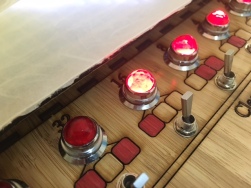Continuing my cellular automata theme, I’ve just finished a device to allow some hands on play, and exploration of the space of 1D cellular automata.

I spent a while thinking on the interface, and settled on the row of switches to set the ‘rule’ for children of each possible 3 parent combination.

The gorgeous jewelled indicators were taken from the World’s Largest Electronics Collection, which I picked up previously and had to make an elaborate set of shelves to hold.
I’ve left space for a 7 segment display on the right hand side, to show the rule number in Wolfram Notation. Sadly I don’t have any in my parts bin just yet, so it’ll stay blank for a while.
I spent ages playing with various diffusers for the LED matrix, and settled on this combination of rice paper with a clear polypropelene layer for protection.
The lasercut mask underneath is rectangular, but with rounded edges. I wanted something to show the connectivity in the simulation was much stronger in the horizontal (“Space”) direction than in the vertical (“Time”) direction.

The colour matching of the LEDs looks much worse in this photo than in real life. Also occasionally these photo will ‘lie’ as to whether a single pixel was lit or not, since the LEDs are PWM’d to get brightness control.
Down the bottom left is a switch to specify whether the sim should start with a random configuration, or with a single centre pixel.
There’s three buttons to control the sim, Clear, Step (takes a single step) and Auto (steps continuously while held).
It’s rather satisfying to play with different rules and see how various patterns emerge:

Rule 30 in action
Files are here for anyone that wants them: http://www.thingiverse.com/thing:1788244
It uses a pair of LED matrixes from Jaycar: http://www.jaycar.com.au/white-led-dot-matrix-display-for-arduino/p/XC4622

Rule 110, which is Turing Complete

Pingback: Una máquina con botones y ledes para explorar los autómatas celulares | obiKuo
Pingback: Una máquina con botones y ledes para explorar los autómatas celulares | Blog de Alcocer Sotil
Pingback: Una máquina con botones y ledes para explorar los autómatas celulares | Ykaly
Pingback: Una máquina con botones y ledes para explorar los autómatas celulares – Tecnologia
Pingback: Cellular Automata Explorer | Hackaday
Pingback: The Collatz-O-Matic | Tinkerings